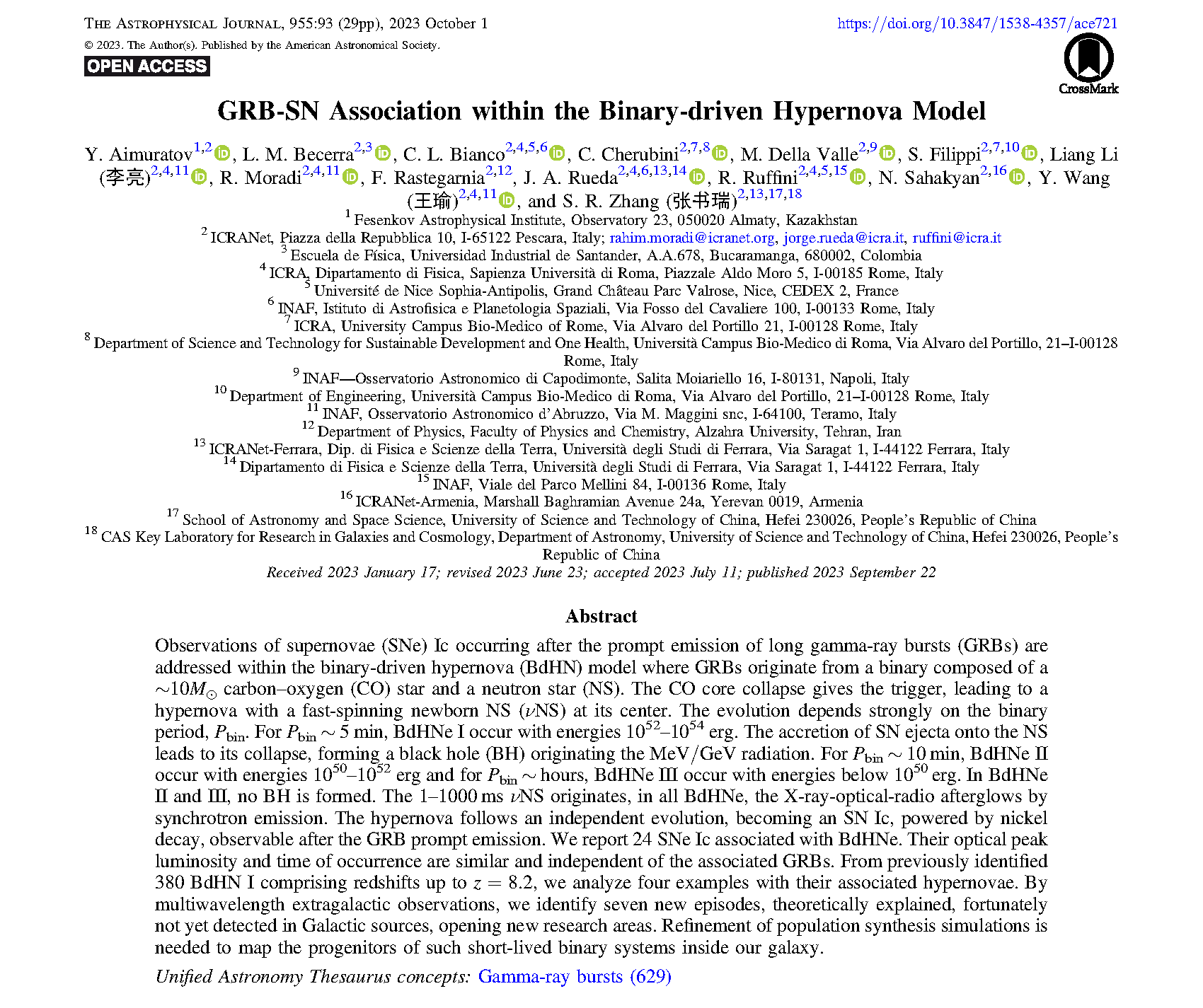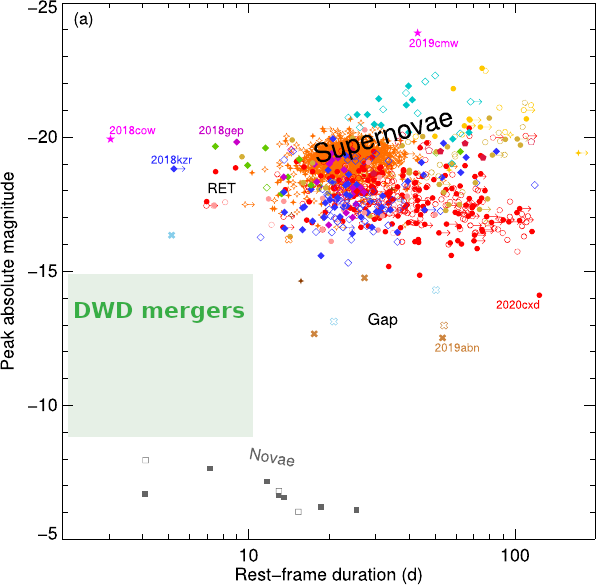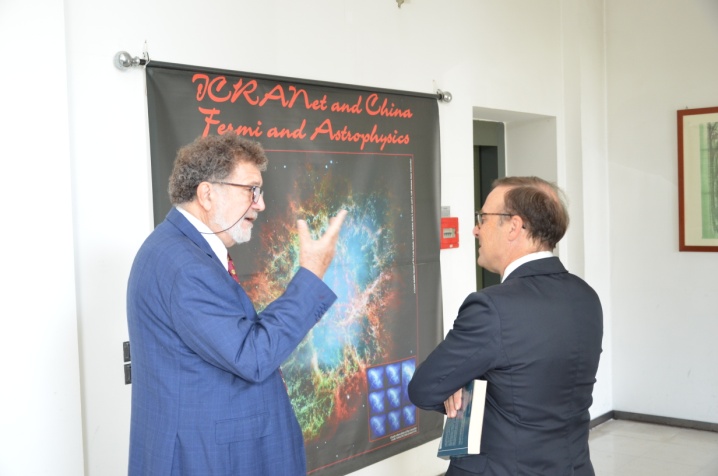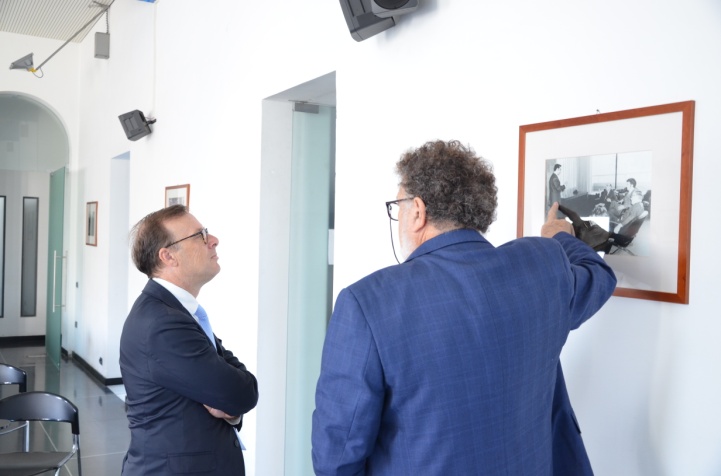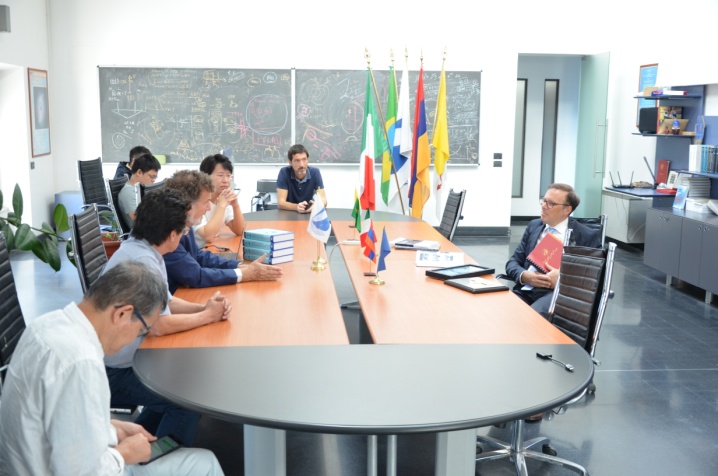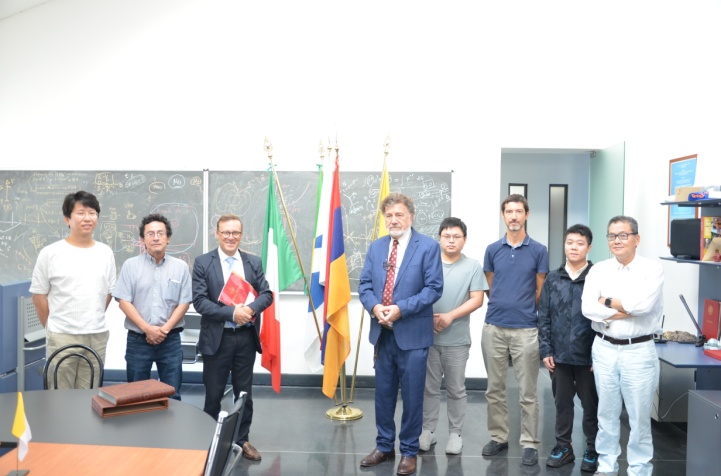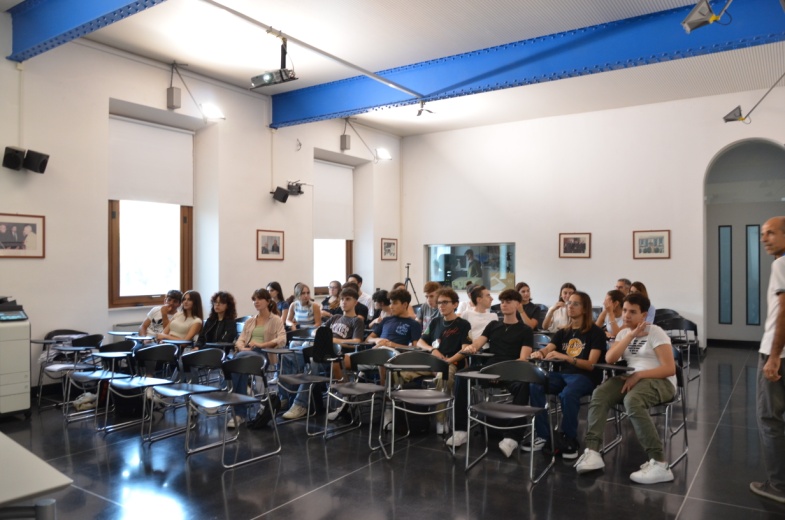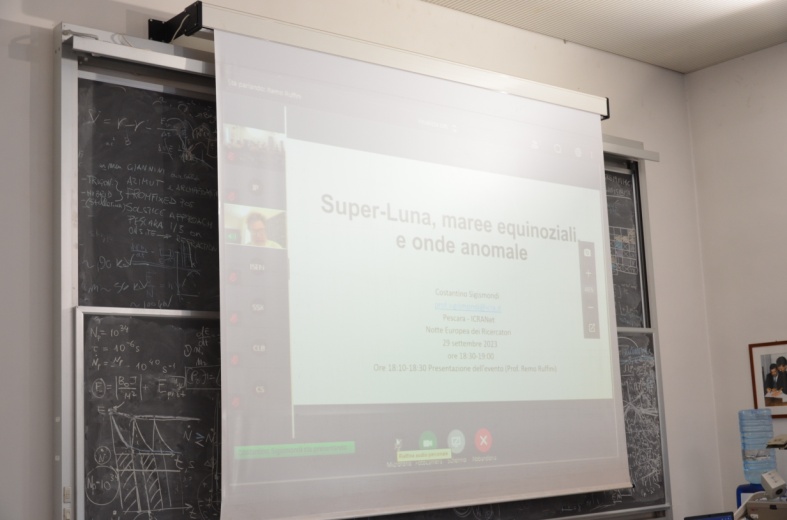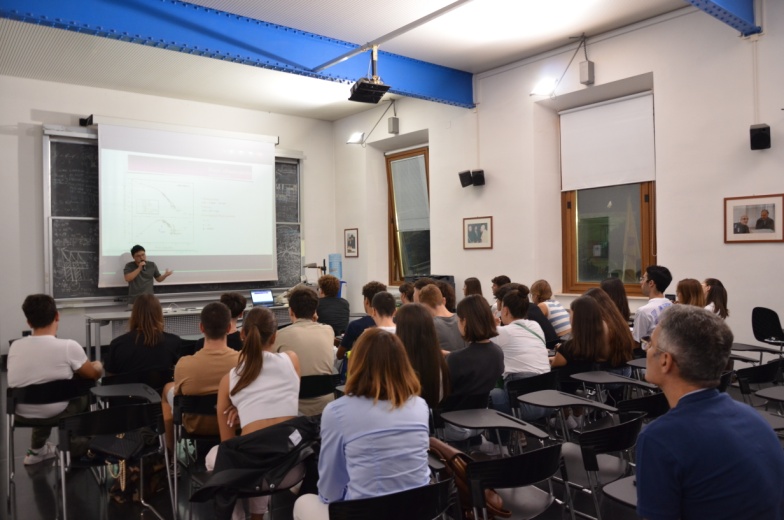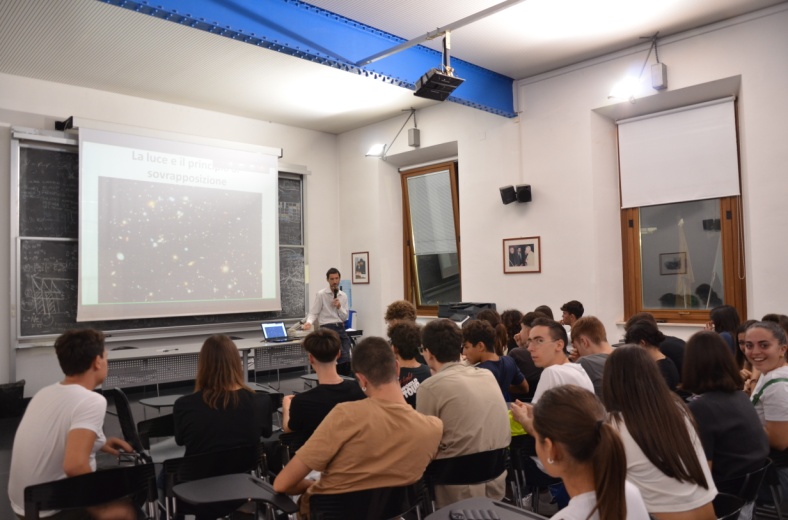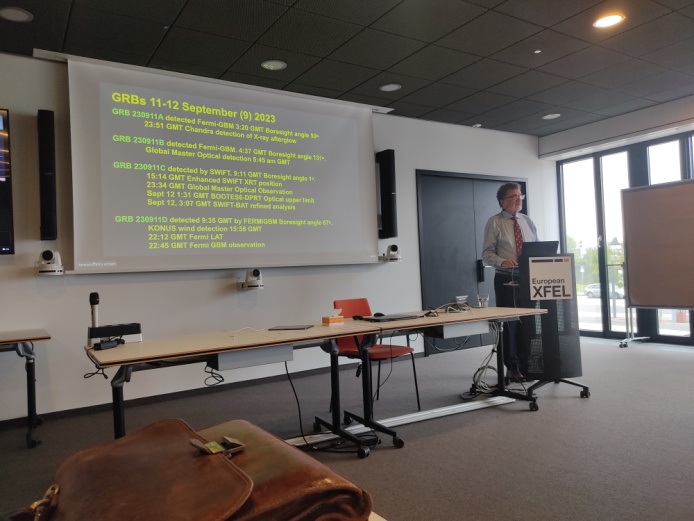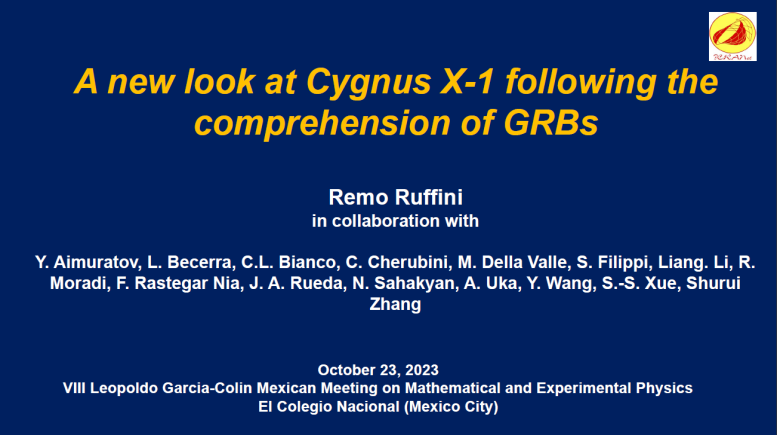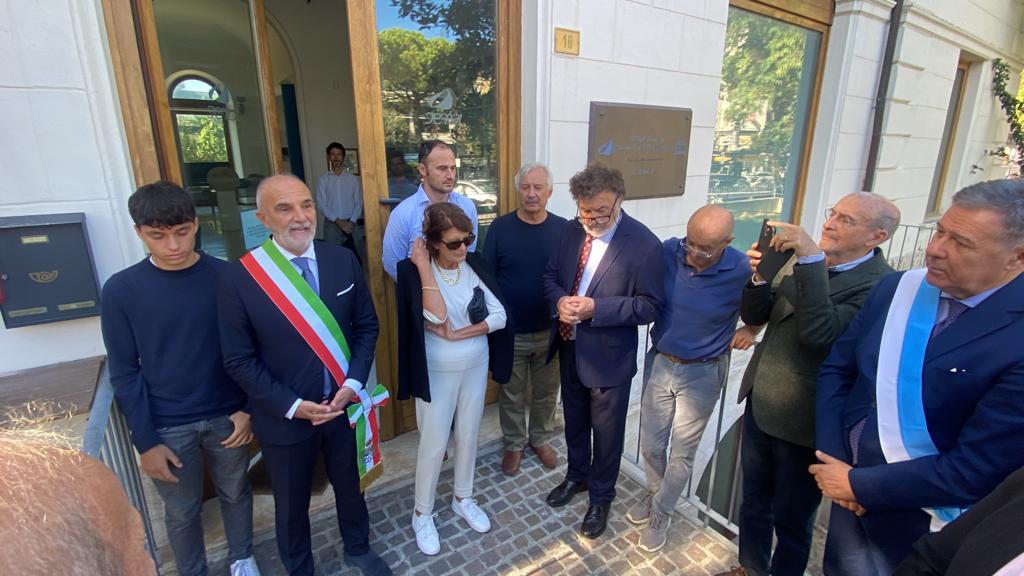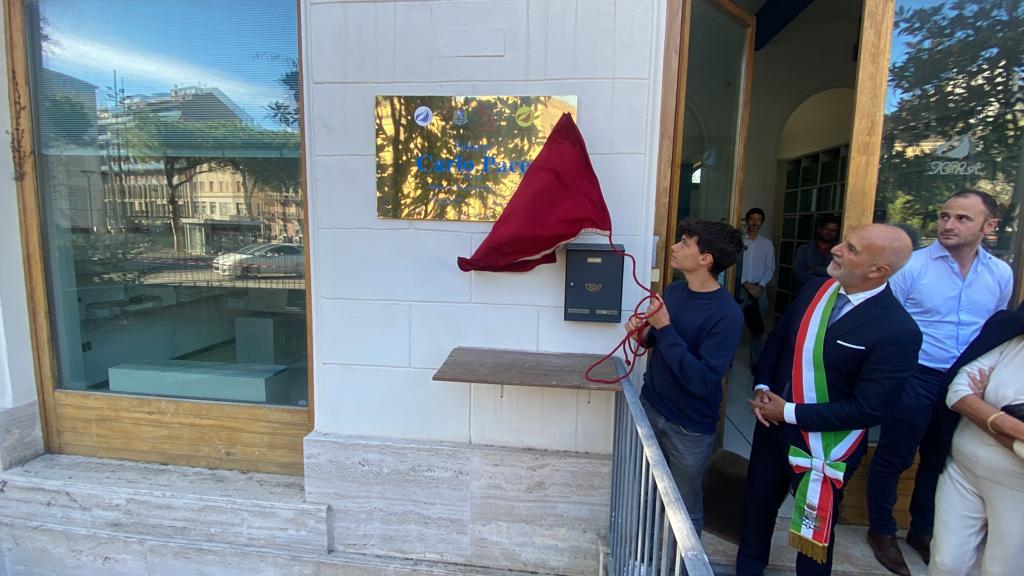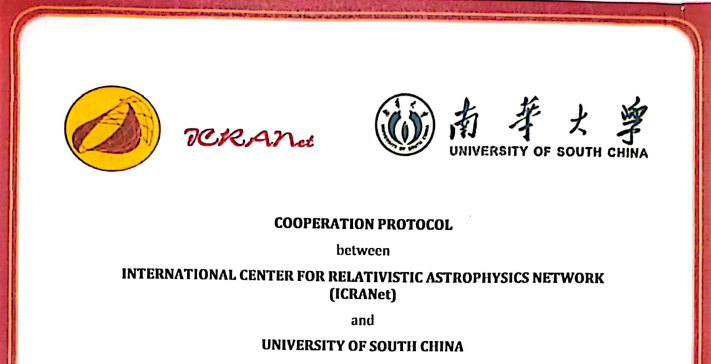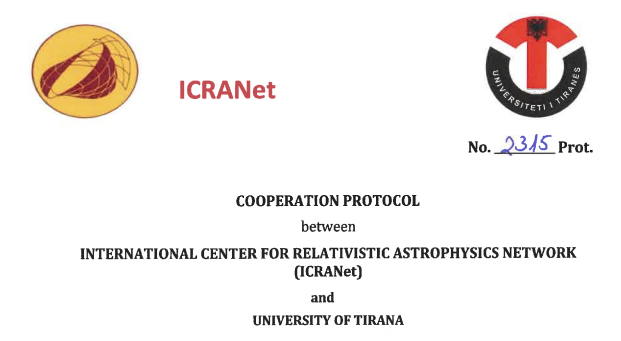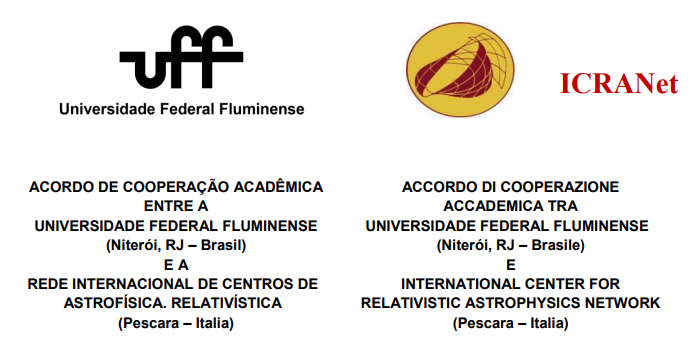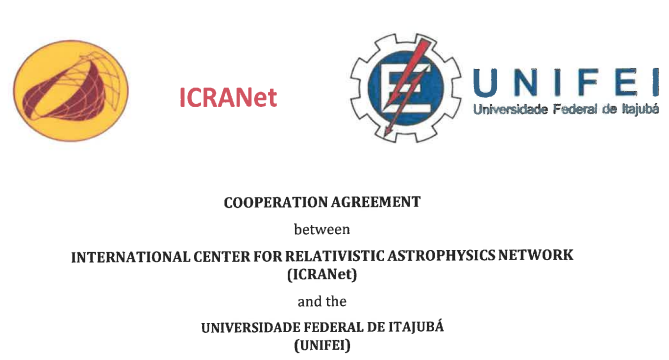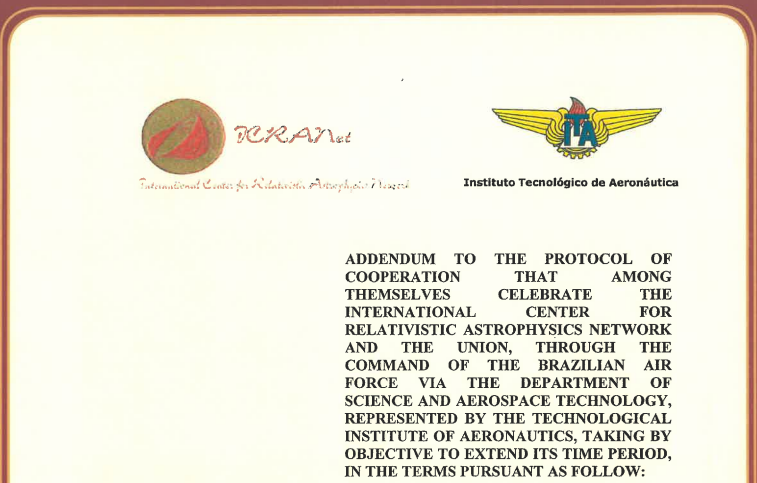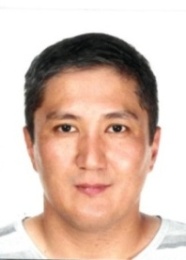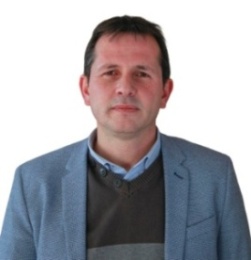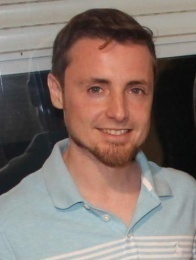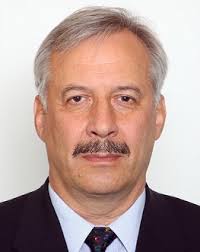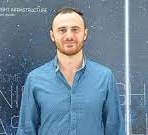

| Newsletter Italian September/October 2023 |

|

|



ICRANet Newsletter
2014 -
2015 -
2016
2017 - 2018 - 2019 2020 - 2021 - 2022 2023 February/March - April/May - June-July-August - September/October
ICRANet Newsletter
Settembre/Ottobre 2023
SOMMARIO
1. L’articolo “GRB-SN Association within the Binary-Driven Hypernova Model” by Aimuratov at al., pubblicato in ApJ, 955 (2023) 93, 1 Ottobre 2023 2.Comunicato stampa ICRA-ICRANet “A New Predicted Class of Astrophysical Sources: White Dwarf Binary Mergers Poised for Discovery at The Vera Rubin Observatory”, 2 Novembre 2023 3. GCN ICRANet 34779, 28 Settembre 2023 4. Visita di S.E. Giancarlo Di Vincenzo, Prefetto di Pescara, presso il centro ICRANet di Pescara, 12 Ottobre 2023 5. La Notte europea dei Ricercatori, 29 Settembre 2023 6. European XFEL Science Seminar del Prof. Ruffini, XFEL Amburgo (Germania),12 Settembre 2023 7. Partecipazione dell’ICRANet al VIII Leopoldo Garcia-Colin Mexican Meeting on Mathematical and Experimental Physics, 23-27 Ottobre 2023, Città del Messico (Messico) 8. Intitolazione del palazzo ICRANet a Carlo Pace, Pescara (Italia), 28 Ottobre 2023 9. Nuovo protocollo di cooperazione tra l’ICRANet e la University of South China, 28 Settembre 2023 10. Rinnovo di 5 accordi di cooperazione ICRANet con l’Accademia nazionale delle Scienze di Bielorussia (NASB), Università di Tirana, Universidade Federal Fluminense (UFF), Universidade Federal de Itajubà (UNIFEI) e Instituto Tecnológico de Aeronáutica (ITA) 11. Visite scientifiche presso l’ICRANet 12. Pubblicazioni recenti
1.L’articolo “GRB-SN Association within the Binary-Driven Hypernova Model” by Aimuratov at al., pubblicato in ApJ, 955 (2023) 93, 1 Ottobre 2023
Articolo di riferimento:
Y. Aimuratov, L. M. Becerra, C.L. Bianco, C. Cherubini, M. Della Valle, S. Filippi, Liang Li, R. Moradi, F. Rastegarnia, J. A. Rueda, R. Ruffini, N. Sahakyan, Y. Wang, S. R. Zhang, GRB-SN Association within the Binary-Driven Hypernova Model, ApJ, 955 (2023) 93; DOI: https://doi.org/10.3847/1538-4357/ace721
Per maggiori dettagli, si prega di consultare la precedente newsletter ICRANet.
2.Comunicato stampa ICRA-ICRANet “A New Predicted Class of Astrophysical Sources: White Dwarf Binary Mergers Poised for Discovery at The Vera Rubin Observatory”, 2 Novembre 2023
Astrophysicists are about to take an important step forward: recent research that will be published in The Astrophysical Journal anticipates that the Vera Rubin Observatory (VRO), scheduled to release the first public data in 2025, will be able to observe a new type of astrophysical source: the merger of binary systems of white dwarfs. The research was conducted by an Italian team from the International Center for Relativistic Astrophysics Network(ICRANet) and the University of Ferrara, associates of the National Institute of Astrophysics (INAF), together with Brazilian colleagues from the Instituto Nacional de Pesquisas Espaciais (INPE), the Universidade Federal do Espìrito Santo (UFES), and the Universidade Tecnologica Federal do Paranà (UTFPR).
In some cases, it is believed that mergers of binary white dwarfs occur in a completely destructive way, producing a supernova explosion called Ia. These supernovae are regularly observed from distant galaxies. However, many of these mergers can follow a different fate: they form a massive white dwarf with an associated transient source less luminous than a supernova and with a more rapid evolution. Although they are estimated to be very abundant, these less catastrophic mergers have escaped any observation by current telescopes, as they are not sufficiently sensitive. The research predicts that the emission produced by mergers of binary systems of white dwarfs, in wavelengths from infrared to ultraviolet, will be observed by VRO with an astonishing frequency, up to a thousand per year!
The light source emitted by the material expelled at high speed (about 1000 km/s) with temperatures of 100thousand degrees for a few hours, is 10 to 100 million times brighter than the Sun. However, the rapid expansion causes the material to cool quickly, making their identification elusive. The most exciting result of the research is that, by putting together the expected population of these mergers and their emission characteristics, the researchers estimated that VRO, equipped with cutting-edge instrumentation and a wide field of view, is ready to discover these mergers in great abundance. Observing these stellar mergers will allow unprecedented insights into their birth and evolution if the predictions are confirmed. The authors say such observations will profoundly impact our knowledge of astrophysical phenomena linking massive white dwarfs to the formation of neutron stars. They will also provide crucial information on the possible generation of Type Ia supernovae from binary white dwarf mergers.
To the various types of transient sources that VRO is preparing to discover in abundance, we add the merger of binary systems of white dwarfs, whose observations will offer a revolutionary contribution to the knowledge of the life and evolution of these types of stars, including the genesis of ultraintense magnetic fields.
Contatti:
Prof. Jorge A. Rueda ICRANet Faculty E-mail: jorge.rueda@icra.it
Articolo di riferimento: On the optical transients from double white-dwarf mergers
Authors: M.F. Sousa, J.G. Coelho, J.C.N. de Araujo, C. Guidorzi, J.A. Rueda Acettato per la pubblicazione in The Astrophysical Journal Prestampa: https://arxiv.org/abs/2310.06655
Per il comunicato stampa sul sito ICRANet:http://www.icranet.org/index.php?option=com_content&task=view&id=1032&Itemid=920
In Italia:
In Brasile:
Subject: transient AT2023sva: A Binary Driven Hypernova with a possible associated supernova
Date:2023-09-28T16:05:44Z From: Remo Ruffini at ICRA Via:Web form
R. Ruffini, Y. Aimuratov, L. Becerra, C.L. Bianco, C. Cherubini, S. Filippi, Liang Li, R. Moradi, F. Rastegar Nia, J.A. Rueda, N. Sahakyan, Y. Wang, S.S. Xue, S.R. Zhang, on behalf of the ICRANet team, report:
Following the BdHN classification [Aimuratov, et al., ApJ 955 (2023) 93] and the determination of the redshift z=2.2 of transient AT2023sva(de Ugarte Postigo, et al., GCN34740), from the energetics evaluated by Liang Li (2023) from Fermi GBM data in (2.15+/-0.13)x10^{52} erg (see attached figure), we conclude that the source is a BdHN II (GRB230916A).
We Propose to look with the James Webb Space Telescope the appearance of the associated supernova (SN) on October 31 (+/-1 day), in order to extend the GRB-SN connection in the range 1
4.Visita di S.E. Giancarlo Di Vincenzo, Prefetto di Pescara, presso il centro ICRANet di Pescara, 12 Ottobre 2023
Il 12 Ottobre 2023, il Prefetto di Pescara, S.E. Giancarlo Di Vincenzo, ha visitato il centro ICRANet a Pescara. Il Prof. Remo Ruffini, Direttore ICRANet, ha mostrato e presentato a lui il centro, la biblioteca con i suoi preziosi libri, le foto ed i documenti conservati nello stabile. Il Prof. Ruffini gli ha anche illustrato le attuali attività dell’ICRANet, nonché i principali temi di ricerca, i risultati ottenuti ed i progetti attualmente in corso. È stato inoltre sottolineato e discusso l’importante ruolo dell’ICRANet nel favorire quotidianamente gli scambi scientifici a livello mondiale e nello stabilire accordi con le principali università e istituti di ricerca del mondo.
Il Dr Di Vincenzo ha incontrato anche lo staff ICRANet, la Faculty ed i ricercatori, che gli hanno illustrato le loro ricerche nonché la loro esperienza a Pescara.
Come ogni anno, l’ICRANet ha organizzato un evento in occasione della Notte europea dei Ricercatori, al fine di creare una piacevole occasione di confronto tra cittadini e ricercatori. L’evento ha attirato l’attenzione di molte persone, come ogni anno, ed ha offerto ai visitatori un’opportunità unica per partecipare ad attività scientifiche volte a mostrare sia il fascino della ricerca come carriera sia il suo significativo impatto sulla società. L’evento si è tenuto presso il centro ICRANet di Pescara, a Nizza ed online, venerdì 29 Settembre 2023, dalle h 16:00 alle h 22:00.
Dopo i saluti d’apertura del Prof. Ruffini, Direttore ICRANet, il meeting è iniziato presso la sede ICRANet a Villa Ratti (Nizza - Francia) - ed è stato trasmesso online in tutto il mondo, dove il Prof. Ruffini ha presentato il suo talk “Buchi neri nell’Universo”, seguito dal talk del Prof. Joseph Kouneiher (Presidente del Projet Archimedes E.C.A.) intitolato “Les Rencontres de Villa Ratti”.
Subito dopo, l'incontro si è tenuto nel centro ICRANet di Pescara (trasmesso online in tutto il mondo) ed ha visto la partecipazione degli studenti di due classi del Liceo scientifico Galileo Galilei di Pescara, sotto la supervisione della loro tutor, la Prof.ssa Tiziana Pompa. Il Prof. Costantino Sigismondi (collaboratore di ICRANet ed ITIS Galileo Ferraris, Roma) ha presentato un intervento intitolato “Super Luna, mare equinoziali ed onde anomale”, seguito dal Dr Liang Li (Faculty ICRANet) che ha presentato il suo talk “La fonte di energia del GRB 230916” e dal Prof. Gregory Vereshchagin (Faculty ICRANet) che ha presentato il suo talk “Creazione di elettroni-positroni ed esclusione di Pauli”.
Inoltre, dalle h 18 alle h 21, il centro ICRANet a Pescara è stato aperto alla popolazione per delle visite guidate, in occasione delle quali i membri della Faculty ICRANet hanno risposto alle domande dei visitatori.
Alle h 21, il meeting è proseguito con la trasmissione della conferenza del Prof. Jorge A. Rueda Hernandez (Professore della Faculty ICRANet e dell’Università di Ferrara) dal titolo “Universo invisibile”, nell'ambito del progetto “Universo a km0”. Questa conferenza si è tenuta a Marano di Valpolicella (Italia) ed è stata seguita dall’osservazione di Saturno con i telescopi.
I saluti conclusivi sono stati presentati dal Prof. Ruffini, che ha ringraziato tutti i partecipanti per aver aderito a questo evento.
Il programma dell’evento è consultabile al seguente link:http://www.icranet.org/documents/program_ruropean_researchers_night_2023.pdf
Il 12 Settembre 2023, il Prof. Ruffini, Direttore ICRANet, accompagnato dal Prof. Arban Uka (Epoka University – Albania), è stato invitato a tenere un seminario presso il centro XFEL ad Amburgo (Germania). Questo seminario è stato inserito nella serie degli “European XFEL Science Seminars”, che si tengono regolarmente ad Amburgo. Il seminario presentato dal Prof. Ruffini era intitolato “GRB220101A the most powerful GRB with seven BdHN Episodes observed”; di seguito l’astract:
A long GRB that occurred at 2022-01-01 05:11:13 (UT), was triggered by multiple satellites, including Swift (Tohuvavohu et al. 2022), Fermi (Arimoto et al. 2022), AGILE (Ursi et al. 2022), and Konus-Wind (Tsvetkova et al. 2022). The optical observation by Xinglong -2.16 m telescope (Fu et al. 2022) revealed a broad absorption feature in the spectrum indicating the presence of Lyman alpha absorption, as well as from the absorption lines, the redshift was determined to be z= 4.61, which was confirmed by the Liverpool telescope (Perley 2022) and NOT (Fynbo et al. 2022). The burst exhibited a bright , complex multi-peaked time profile within the first ~ 150 s. An estimated isotropic equivalent energy is of Eiso~4x1054 erg, and a peak luminosity is of Lp~ 9 x 1053 erg s-1, making GRB 220101 A as one of the most luminous GRB ever observed. The fact that it occurs at z=4.6 gives a great opportunity to exploit new perspectives of observations as presented in Bianco et al. 2023. The discovery of a radio source with a mean frequency of 6.0 GHz was reported in Laskar (2022a). This finding aligns with the X-ray position noted in Osborne et al. (2022), as well as the optical positions reported by Tohuvavohu et al. 2022 and Hentunen et al. (2022), along with the mm-band position mentioned in Laskar (2022b). All seven episodes characterizing a BdHN I, as predicted in Ruffini et al. (2022 a,b), have been identified, details are presented in Ruffini et al., (submitted). our attention in this article is to identify the earliest XRT observations made possible by the use of the cosmological redshift of z=4.61 and to obtain an unprecedented accurate description of the rising part and the power-law decay part of the x-ray emission evidencing the transition from a Jacobi ellipsoid into a Mac Laurin spheroid in the description of a new NS originating the afterglow.
In questa occasione, il Prof. Ruffini ha visitato i centri ed i laboratori di XFEL e DESY, ed ha incontrato la Prof.ssa Sakura Pascarelli (Direttrice scientifica di XFEL) e la Prof.ssa Beate Heinemann (Direttore incaricato della fisica delle particelle in DESY).
Per l’annuncio del seminario sul sito di EuXFEL: https://indico.desy.de/event/39848/
7.Partecipazione dell’ICRANet al VIII Leopoldo Garcia-Colin Mexican Meeting on Mathematical and Experimental Physics, 23-27 Ottobre 2023, Città del Messico (Messico)
Il 23 Ottobre 2023, il Prof. Ruffini, Direttore ICRANet, è stato invitato a presentare una conferenza plenaria in occasione del “VIII Leopoldo Garcia-Colin Mexican Meeting on Mathematical and Experimental Physics”, che si è tenuto a Città del Messico (Messico) dal 23 al 27 Ottobre 2023.
Lunedì 23 Ottobre, il Prof. Ruffini ha presentato un talk dal titolo “A new look at Cygnus X-1 following the comprehension of GRBs-2”; di seguito l’abstract:
The understanding of Gamma-Ray Bursts (GRBs) has used, as successful models, progenitors binary systems of massive stars of mass up to 18 solar masses. Such progenitors evolve themselves in a supernova (SN) event: the most massive of the binary undergoes an SN, forming a neutron star (NS), which remains bound to the companion less massive binary star companion. The NS induces a co-rotation on the CO core of the companion star, which undergoes a gravitational collapse, leading to an SN creating a new NS (vNS). The SN ejecta accreting onto the companion NS binary leads to the forming of a Black Hole (BH). The newly formed BH and the vNS are the basic components of the most powerful GRBs: 10 examples of CO-core collapse triggering the GRB process will be presented. The BH originates by electrodynamics process to the observed GeV emission, while the fat spinning vNS leads to the observed X-ray, optical, and radio emission of the GRB afterglow. Some preliminary results for the evolution of binary systems composed of masses higher than 18 solar masses connected to Cygnus X-1, here revisited 50 years after I identified it as a BH for the first time at the Sixth Texas Symposium on Relativistic Astrophysics in New York on December 18-22, 1972.
Per la registrazione della conferenza plenaria del Prof. Ruffini, disponibile sul canale YouTube dell’ICRANet: https://www.youtube.com/watch?v=b00i6iKr5WM
Il palazzo dell’ICRANet, situato in Piazza della Repubblica 10 a Pescara (Italia), è stato dedicato al Dr Carlo Pace, ex Sindaco di Pescara dal 1994 al 2003, morto accidentalmente nel 2017. Per celebrare questa intitolazione, è stata organizzata una cerimonia ufficiale dal Comune di Pescara il giorno Sabato 28 Ottobre 2023.
Alla cerimonia hanno preso parte eminenti autorità locali e nazionali, quali il Sindaco di Pescara Carlo Masci, il Presidente del Consiglio regionale Lorenzo Sospiri, il Presidente del Consiglio comunale Marcello Antonelli, il deputato italiano Nazario Pagano, numerosi assessori e consiglieri comunali ed il Prorettore dell’Università di Chieti - Pescara Gabriele D’Annunzio Tonio Di Battista. Alla cerimonia hanno partecipato anche la famiglia di Carlo Pace, autorità civili e militari, esponenti del mondo accademico e della cultura, nonché una delegazione di studenti dell’Istituto tecnico Tito Acerbo di Pescara.
Nei primi anni 2000, Carlo Pace ebbe l’idea di trasformare l’ex stazione ferroviaria di Pescara in un brillante centro di ricerca, l’ICRANet, poiché voleva proiettare Pescara, la città di cui era innamorato, nella conoscenza del mondo e delle stelle, che guarda al futuro. Come ben espresso dal sindaco Masci, Carlo Pace aveva una grande visione, grandi competenze e onestà. L'intitolazione a lui dell'edificio è stata fortemente voluta dal Comune di Pescara, per ricordare una personalità di spicco della vita amministrativa cittadina, che ha svolto il suo lavoro con abnegazione, realizzando una brillante opera culturale e umana e diventando un insostituibile punto di riferimento per gli amministratori.
Il Prof. Ruffini, Direttore ICRANet, ha tratto gli auspice affinché le istituzioni locali e l’Università stiano al fianco di ICRANet, nel nome di Carlo Pace che credette molto in questa realtà. Egli si augura che questi spazi divengano sempre più luoghi di scienza e di ricerca per un numero in crescita di dottorandi, come quelli che sono stati formati dal’ICRANet.
Per i comunicati stampa (in italiano):
Per i video (in italiano):
Il 9 Settembre 2023, l’ICRANet ha firmato un nuovo protocollo di cooperazione con la University of South China (USC) in Cina. Il protocollo di cooperazione è stato firmato dal Prof. Dr. Zhang Zhuohua (Presidente USC), dal Prof. Dr. Wenbin Lin (Presidente della Facoltà di matematica e fisica USC), dal Prof. Remo Ruffini (Direttore ICRANet) e dal Prof. Shesheng Xue (Professore della Faculty ICRANet).
L’accordo sarà valido per 5 anni e le principali attività congiunte da sviluppare nell'ambito di esso comprendono: lo scambio istituzionale di studenti laureati, post-laurea, ricercatori e membri di facoltà, lo sviluppo di attività didattiche e/o di ricerca relative alle aree di competenza e interesse di entrambe le organizzazioni, l'organizzazione di simposi, seminari, conferenze e corsi brevi, la promozione e il sostegno di eventi e attività tecnico-scientifiche e culturali aperte al pubblico; lo sviluppo di opportunità per la formazione di docenti e ricercatori universitari, l'organizzazione di corsi e attività di formazione, nonché lo sviluppo di aree di ricerca interistituzionali associate a programmi di laurea locali; la promozione di pubblicazioni congiunte; l'implementazione di attività orientate al sociale attraverso l'estensione accademica; lo scambio di informazioni relative alle attività di insegnamento e ricerca in entrambe le istituzioni, nonché la richiesta di finanziamenti internazionali per promuovere progetti di ricerca congiunti o implementare programmi di scambio di mobilità.
Per il testo dell’accordo: http://www.icranet.org/index.php?option=com_content&task=view&id=1500
10.Rinnovo di 5 accordi di cooperazione ICRANet con l’Accademia nazionale delle Scienze di Bielorussia (NASB), Università di Tirana, Universidade Federal Fluminense (UFF), Universidade Federal de Itajubà (UNIFEI) e Instituto Tecnológico de Aeronáutica (ITA)
Rinnovo dell’accodo di cooperazione tra l’ICRANet e l’Accademia nazionale delle Scienze di Bielorussia (NASB)
Il 7 Settembre 2023, l’accordo di cooperazione tra l’ICRANet e l’Accademia nazionale delle Scienze di Bielorussia (NASB) è stato rinnovato. Il rinnovo è stato firmato dall’Academician Vladimir G. Gusakov (Presidente del Presidio della NASB), dal Prof. Alexander Shumilin (Presidente del Comitato di Stato per la scienza e la tecnologia della Repubblica di Bielorussia), dal Prof. Remo Ruffini (Direttore ICRANet) e dal Prof. Gregory Vereshchagin (Professore della Faculty ICRANet). Questo accordo sarà valido per ulteriori 5 anni e le principali attività congiunte da sviluppare nell'ambito di esso comprendono: la conduzione di ricerche congiunte su temi scientifici di interesse per entrambe le parti, l'organizzazione di eventi scientifici e scientifico-pratici bilaterali, lo scambio di esperienze tra i dipendenti impegnati nella ricerca e nell'insegnamento, la pubblicazione di lavori scientifici congiunti su riviste internazionali nonché lo scambio di pubblicazioni, materiale didattico e corsi di formazione.
Per il testo dell’accordo: http://www.icranet.org/index.php?option=com_content&task=view&id=1050
Rinnovo del protocollo di cooperazione tra l’ICRANet e l’Università di Tirana (Albania)
Il 14 Settembre 2023, il Protocollo di cooperazione tra l’ICRANet e l’Università di Tirana (Albania) è stato rinnovato. Il rinnovo è stato firmato dal Prof. Dr Artan Hoxha (Rettore dell’Università di Tirana), dalla Prof.ssa Mimoza hafizi (Università di Tirana), dal Prof. Remo Ruffini (Direttore ICRANet) e dal Prof. Jorge A. Rueda H. (Professore della Faculty ICRANet). Questo accordo sarà valido per ulteriori 5 anni e le principali attività congiunte da sviluppare nell'ambito di esso comprendono: la conduzione di ricerche congiunte su temi scientifici di interesse per entrambe le parti, l'organizzazione di eventi scientifici e scientifico-pratici bilaterali, lo scambio di esperienze tra i dipendenti impegnati nella ricerca e nell'insegnamento, la pubblicazione di lavori scientifici congiunti su riviste internazionali nonché lo scambio di pubblicazioni, materiale didattico e corsi di formazione.
Per il testo dell’accordo: http://www.icranet.org/index.php?option=com_content&task=view&id=1187
Rinnovo dell’accordo di cooperazione accademica tra l’ICRANet e l’Universidade Federal Fluminense (UFF)
Il 20 Settembre 2023, l’accordo di cooperazione accademica tra l’ICRANet e l’Universidade Federal Fluminense – UFF (Brasile) è stato rinnovato. Il rinnovo è stato firmato dal Prof. Antonio Claudio Lucas da Nobrega (Rettore UFF) e dal Prof. Remo Ruffini (Direttore ICRANet). Questo accordo sarà valido per ulteriori 5 anni e le principali attività congiunte da sviluppare nell'ambito di esso comprendono: la conduzione di ricerche congiunte su temi scientifici di interesse per entrambe le parti, l'organizzazione di eventi scientifici e scientifico-pratici bilaterali, lo scambio di esperienze tra i dipendenti impegnati nella ricerca e nell'insegnamento, la pubblicazione di lavori scientifici congiunti su riviste internazionali nonché lo scambio di pubblicazioni, materiale didattico e corsi di formazione.
Per il testo dell’accordo: http://www.icranet.org/index.php?option=com_content&task=view&id=1024
Rinnovo dell’accordo di cooperazione tra l’ICRANet e l’Universidade Federal de Itajubà (UNIFEI)
Il 4 Ottobre 2023, l’accordo di cooperazione tra l’ICRANet e l’Universidade Federal de Itajubà - UNIFEI (Brasile) è stato rinnovato. Il rinnovo è stato firmato dal Prof. Dr. Tales Cleber Pimenta (Direttore dell’ufficio relazioni internazionali UNIFEI), dal Prof. Remo Ruffini (Direttore ICRANet) e dal Prof. Jorge A. Rueda H. (Professore della Faculty ICRANet). Questo accordo sarà valido per ulteriori 5 anni e le principali attività congiunte da sviluppare nell'ambito di esso comprendono: la conduzione di ricerche congiunte su temi scientifici di interesse per entrambe le parti, l'organizzazione di eventi scientifici e scientifico-pratici bilaterali, lo scambio di esperienze tra i dipendenti impegnati nella ricerca e nell'insegnamento, la pubblicazione di lavori scientifici congiunti su riviste internazionali nonché lo scambio di pubblicazioni, materiale didattico e corsi di formazione.
Per il testo dell’accordo: http://www.icranet.org/index.php?option=com_content&task=view&id=1021
Renewal of the cooperation agreement between ICRANet and the Instituto Tecnológico de Aeronáutica (ITA)
On October 5, 2023 ICRANet has received the official confirmation that the agreement between ICRANet and - ITA (Brazil)was renewed. The renewal was signed by Prof. Dr. Anderson Ribeiro Correia (Rector of ITA) and by Prof. Remo Ruffini (Director of ICRANet). This agreement will be valid for additional 3 years and the main joint activities to be developed under its framework include: the conduction of joint research on scientific issues of interest to both parties, the organization of bilateral scientific and scientific-practical events, the exchange of experience between employees involved in research and teaching, the publication of joint scientific works in international journals as well as the exchange of publications, teaching materials and lecture courses.
For the text of the agreement: http://www.icranet.org/index.php?option=com_content&task=view&id=1014
Durante la loro visita, questi scienziati hanno avuto l'opportunità di discutere le loro ricerche scientifiche e di avere interessanti scambi con gli altri ricercatori dell'ICRANet e da diverse parti del mondo.
Y. Aimuratov, L. M. Becerra, C.L. Bianco, C. Cherubini, M. Della Valle, S. Filippi, Liang Li, R. Moradi, F. Rastegarnia, J. A. Rueda, R. Ruffini, N. Sahakyan, Y. Wang, S. R. Zhang, GRB-SN Association within the Binary-Driven Hypernova Model, published in The Astrophysical Journal 955:93 (29pp), on October 1, 2023.
Observations of supernovae (SNe) Ic occurring after the prompt emission of long gamma-ray bursts (GRBs) are addressed within the binary-driven hypernova (BdHN) model where GRBs originate from a binary composed of a ∼10M⊙carbon–oxygen (CO) star and a neutron star (NS). The CO core collapse gives the trigger, leading to a hypernova with a fast-spinning newborn NS (νNS) at its center. The evolution depends strongly on the binary period, Pbin. For Pbin∼ 5 min, BdHNe I occur with energies 1052–1054 erg. The accretion of SN ejecta onto the NS leads to its collapse, forming a black hole (BH) originating the MeV/GeV radiation. For Pbin∼ 10 min, BdHNe II occur with energies 1050–1052 erg and for Pbin∼ hours, BdHNe III occur with energies below 1050 erg. In BdHNe II and III, no BH is formed. The 1–1000 ms νNS originates, in all BdHNe, the X-ray-optical-radio afterglows by synchrotron emission. The hypernova follows an independent evolution, becoming an SN Ic, powered by nickel decay, observable after the GRB prompt emission. We report 24 SNe Ic associated with BdHNe. Their optical peak luminosity and time of occurrence are similar and independent of the associated GRBs. From previously identified 380 BdHN I comprising redshifts up to z = 8.2, we analyze four examples with their associated hypernovae. By multiwavelength extragalactic observations, we identify seven new episodes, theoretically explained, fortunately not yet detected in Galactic sources, opening new research areas. Refinement of population synthesis simulations is needed to map the progenitors of such short-lived binary systems inside our galaxy.
Rodríguez, J. F.; Rueda, J. A.; Ruffini, R.; Zuluaga, J. I.; Blanco-Iglesias, J. M.; Lorén-Aguilar, P., Chirping compact stars: gravitational radiation and detection degeneracy with binaries, published in Journal of Cosmology and Astroparticle Physics, Volume 2023, Issue 10, on October 6, 2023.
Compressible, Riemann S-type ellipsoids can emit gravitational waves (GWs) with a chirp-like behavior (hereafter chirping ellipsoids, CELs). We show that the GW frequency-amplitude evolution of CELs (mass ∼ 1 M⊙, radius ∼ 103 km, polytropic equation of state with index n ≈ 3) is indistinguishable from that emitted by double white dwarfs and by extreme mass-ratio inspirals (EMRIs) composed of an intermediate-mass (e.g. 103M⊙) black hole and a planet-like (e.g. 10-4M⊙) companion, in the frequency interval within the detector sensitivity band in which the GW emission of these systems is quasi-monochromatic. For reasonable astrophysical assumptions, the local universe density rate of CELs, double white dwarfs, and EMRIs in the mass range here considered are very similar, posing a detection-degeneracy challenge for space-based GW detectors. We outline the astrophysical implications of this CEL-binary detection degeneracy by space-based GW-detection facilities.
Rueda, J. A.; Ruffini, R.,Extracting the energy and angular momentum of a Kerr black hole, published on the European Physical Journal C, Volume 83, Issue 10, article id.960 on October 2023.
It has been thought for decades that rotating black holes (BHs) power the energetic gamma-ray bursts (GRBs) and active galactic nuclei (AGNs), but the mechanism that extracts the BH energy has remained elusive. We here show that the solution to this problem arises when the BH is immersed in an external magnetic field and ionized low-density matter. For a magnetic field parallel to the BH spin, the induced electric field accelerates electrons outward and protons inward in a conical region, centered on the BH rotation axis, and of semi-aperture angle 0 ≈60°from the BH rotation axis. For an antiparallel magnetic field, protons and electrons exchange their roles. The particles that are accelerated outward radiate off energy and angular momentum to infinity. The BH powers the process by reducing its energy and angular momentum by capturing polar protons and equatorial electrons with net negative energy and angular momentum. The electric potential allows for negative energy states outside the BH ergosphere, so the latter does not play any role in this electrodynamical BH energy extraction process.
Sousa, M. F.; Coelho, J. G.; de Araujo, J. C. N.; Guidorzi, C.; Rueda, J. A., On the optical transients from double white-dwarf mergers, accepted for publication in The Astrophysical Journal.
Double white-dwarf (DWD) mergers are relevant astrophysical sources expected to produce massive, highly-magnetized WDs, supernovae (SNe) Ia, and neutron stars (NSs). Although they are expected to be numerous sources in the sky, their detection has evaded the most advanced transient surveys. This article characterizes the optical transient expected from DWD mergers in which the central remnant is a stable (sub-Chandrasekhar) WD. We show that the expansion and cooling of the merger's dynamical ejecta lead to an optical emission peaking at 1-10 d post-merger, with luminosities of 1040-1041 erg s−1. We present simulations of the light-curves, spectra, and the color evolution of the transient. We show that these properties, together with the estimated rate of mergers, are consistent with the absence of detection, e.g., by The Zwicky Transient Facility (ZTF). More importantly, we show that the Legacy Survey of Space and Time (LSST) of the Vera C. Rubin Observatory will likely detect a few/several hundred per year, opening a new window to the physics of WDs, NSs, and SN Ia.
Punsly B., HST-1 as a window into the energetics of the jet spine of M 87, published in Astronomy & Astrophysics, Volume 677 on September 2023.
We present a new interpretation of the optical knot, HST-1, in the jet of M 87. High-sensitivity 22 GHz Very Large Array images have located HST-1 to within 6 mas of the jet axis immediately upstream. Based on 1.7 GHz Very Long Baseline Array images of a bright flare in 2005, we see that preponderance of emission in the early stages originates from an elongated region that is tilted 12.5° from the jet axis. The superluminal motion, shape, location, and the large jet-aligned optical/UV polarization suggest an identification with the putative relativistic spine of the jet. As such, energy flux estimates for HST-1, ∼870 mas from the nucleus, published in 2006, indicate that the central engine injected, Qspine ≈ 2.5 × 1041 ergs s−1, into the base of the spine about 200 yr earlier. Furthermore, previous studies have revealed a tubular protonic jet on sub-mas scales that envelopes a low luminosity core, presumably the faint spine base. It was estimated that the central engine injected, Qtubular jet ≈ 6.1 × 1041 ergs s−1, about 1.5 yr earlier. If one component of the jet is inherently more powerful, a firm constraint on total jet power in the recent past would then exist. If the emitted jet is inherently dominated by the spine (tubular jet), then the total bilaterally symmetric jet power emitted from the central engine was < 4Qspine ≈ 1.0 × 1042 ergs s−1 (< 4Qtubular jet ≈ 2.4 × 1042 ergs s−1) ∼200 (∼1.5) yr earlier. Assuming a nearly constant central engine injected jet power for ∼200 yr indicates a total jet power of ≲2 × 1042 ergs s−1 in epochs of modern observation or ≲3.5% jet production efficiency for an accretion rate of 0.001 M⊙ yr−1. Seemingly, the focus of Event Horizon Telescope Collaboration (EHTC) numerical models should be biased toward jet powers of ≲2 × 1042 ergs s−1, as opposed to larger estimates from ejections many centuries or millennia earlier.
Benaoum, Hachemi B.; Chavanis, Pierre-Henri; Luongo, Orlando; Muccino, Marco; Quevedo, Hernando, High redshift constraints on extended logotropic models, published in Astroparticle Physics, Volume 151 on September 2023.
A single logotropic fluid, responsible for the existence of the whole dark sector, is here extensively revised at intermediate redshifts. In particular, by investigating possible generalizations that conceptually overcome previous issues of standard logotropic scenarios, we fix bound over classes of logotropic models that exhibit additional terms in the equation of state. Employing σ8 measurements combined with low redshift data sets of Supernovae and Hubble observational data, we show the statistical significance of those extensions and their departure from the standard cosmological model. Evidences against generalized versions of logotropic models are, in particular, prompted. Our outcomes definitively show that any departure from the original logotropic model, including the Anton–Schmidt dark energy, are clearly disfavored at the level of perturbations and/or background cosmology. This indicates that, in order to have a logotropic fluid, plausible generalized versions of it would point out to reduce the complexity of the fluid itself, instead of adding extra terms.
Guetta, Dafne; Langella, Aurora; Gagliardini, Silvia; Della Valle, Massimo, Low- and High-energy Neutrinos from SN 2023ixf in M101, published in The Astrophysical Journal Letters, 955:L9 (7pp) on September 20, 2023.
Supernova (SN) 2023ixf in M101 is the closest SN explosion observed in the last decade. Therefore, it is a suitable test bed to study the role of jets in powering the SN ejecta. With this aim, we explored the idea that high-energy neutrinos could be produced during the interaction between the jets and the intense radiation field produced in the SN explosion and eventually be observed by the IceCube neutrino telescope. The lack of detection of such neutrinos has significantly constrained both the fraction of stellar collapses that produce jets and/or the theoretical models for neutrino production. Finally, we investigated the possibility of detecting low-energy neutrinos from SN 2023ixf with the Super- and Hyper-Kamiokande experiments, obtaining, in both cases, subthreshold estimates.
A. Bagheri Tudeshki, G.H. Bordbar, B. Eslam Panah, Effect of massive graviton on dark energy star structure, published in Physics of the Dark Universe, Volume 42, on October 2023.
The presence of massive gravitons in the field of massive gravity is considered an important factor in investigating the structure of compact objects. Hence, we are encouraged to study the dark energy star structure in the Vegh's massive gravity. We consider that the equation of state governing the inner spacetime of the star is the extended Chaplygin gas, and then using this equation of state, we numerically solve the Tolman-Oppenheimer-Volkoff (TOV) equation in massive gravity. In the following, assuming different values of free parameters defined in massive gravity, we calculate the properties of dark energy stars such as radial pressure, transverse pressure, anisotropy parameter, and other characteristics. Then, after obtaining the maximum mass and its corresponding radius, we compute redshift and compactness. The obtained results show that for this model of dark energy star, the maximum mass and its corresponding radius depend on the massive gravity's free parameters and anisotropy parameter. These results are consistent with the observational data and cover the lower mass gap. We also demonstrate that all energy conditions are satisfied for this model, and in the presence of anisotropy, the dark energy star is potentially unstable.
H. Barzegar, B. Eslam Panah, G. H. Bordbar, and M. Bigdeli, Structure of 3D gravastars in the context of massive gravity, published in Phys. Lett. B 847 (2023) 138280.
In this paper, we investigate a new model of dimensional (3D) gravitational vacuum stars (gravastars) with an isotropic matter distribution anti-de Sitter (AdS) spacetime in the context of massive gravity. For this purpose, we explore free singularity models with a specific equation of state. Using Mazur-Mottola's approach, we predict 3D gravastars as alternatives to BTZ black holes in massive gravity. We find analytical solutions to the interior of gravastars free of singularities and event horizons. For a thin shell containing an ultra-relativistic stiff fluid, we discuss length, energy, and entropy. In conclusion, the parameter of massive gravity plays a significant role in predicting the proper length, energy contents and entropy and parameters of gravastars.
B. Eslam Panah, M. Khorasani, and J. Sedaghat, Three-dimensional accelerating AdS black holes in F(R) gravity, published in Eur. Phys. J. Plus 138 (2023) 728.
The presence of massive gravitons in the field of massive gravity is considered an important factor in investigating the structure of compact objects. Hence, we are encouraged to study the dark energy star structure in the Vegh’s massive gravity. We consider that the equation of state governing the inner spacetime of the star is the extended Chaplygin gas, and then using this equation of state, we numerically solve the Tolman–Oppenheimer–Volkoff (TOV) equation in massive gravity. In the following, assuming different values of free parameters defined in massive gravity, we calculate the properties of dark energy stars such as radial pressure, transverse pressure, anisotropy parameter, and other characteristics. Then, after obtaining the maximum mass and its corresponding radius, we compute redshift and compactness. The obtained results show that for this model of dark energy star, the maximum mass and its corresponding radius depend on the massive gravity’s free parameters and anisotropy parameter. These results are consistent with the observational data and cover the lower mass gap. We also demonstrate that all energy conditions are satisfied for this model, and in the presence of anisotropy, the dark energy star is potentially unstable.
|
||||||||||||||||||||||||||||||||||||||||||||||||
|
||
